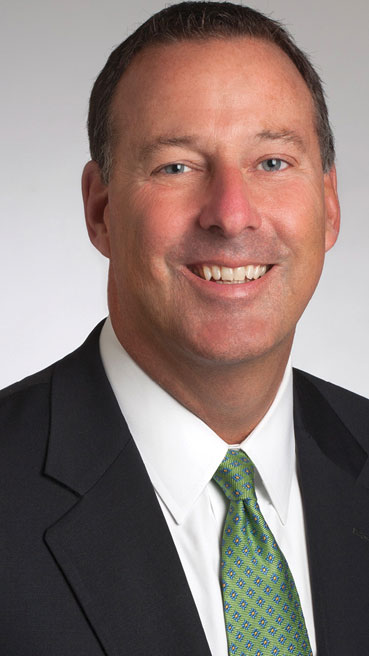After run of acquisitions, People’s United focuses on organic growth, tech
Change is the byword at People”™s United Bank. With the dust still settling on its $544 million acquisition of Farmington Bank and on its impressive third-quarter results, People”™s is still wrestling with the technological and cybersecurity issues facing most industries today ”” particularly in the financial services sector.
Not only that, but People”™s United named a new president, Jeff Tengel, in May. Jack Barnes, formerly both president and CEO, is continuing to serve in the latter role.

“Jack is transparent, very communicative and collaborative,” Tengel said at the Bridgeport bank”™s 850 Main St. headquarters. “He”™s really helped make it an easy transition for me.”
Also helping is the bank”™s continued strong performance. Net income for the quarter ended Sept. 30 was $117 million, up nearly 29 percent from the year-ago quarter”™s $90.8 million, while operating revenue increased by 27.4 percent to $113.8 million from $89.3 million for the same period. Total assets as of Sept. 30 were $47 billion.
The addition of Farmington Bank parent First Connecticut Bancorp “further strengthens the franchise”™s earnings power, as we are confident in achieving the transaction”™s attractive financial returns,” Barnes said when announcing the Q3 results. “Integration has progressed well and the core system conversion will take place in January.”
That integration includes the Nov. 5 announcement that People”™s United will close 15 branches ”” 13 of them Farmington Bank operations, and none in Fairfield County ”” through what Tengel said was a collaborative decision by the two banks. Those branches will shutter at the end of January, he said, noting that all affected employees have been offered positions within People”™s United.
As for integrating the two banks, Tengel said such efforts fall into “two big buckets.”
“The cultural integration has gone pretty well,” he said. “We were very familiar with a number of their employees, a number of whom used to work at our bank years ago. From a cultural baseline, it”™s been smoother than with the integration of our technologies.”
That process is “going a little bit slower,” he said. “We need to get them up to speed on how we do some of the things we do at our company, in terms of how we process loans, deposits ”¦ the blocking and tackling that”™s involved.”
The Farmington deal was the culmination of a run of acquisitions for People”™s, which last year included picking up Philadelphia”™s Leaf Commercial Capital and Long Island”™s Suffolk Bancorp. Those deals were done in part to expand the Bridgeport bank”™s profile both regionally ”” the Suffolk deal added 28 branches to push People”™s total to over 400 ”” and nationally, as Leaf had financed nearly $6 billion for more than 243,000 customers across the U.S. before being acquired.
Tengel said the bank is continuing to explore opportunities for further growth, though another acquisition is not imminent. “We evaluate opportunities as they come up,” he said. “We will entertain potential acquisitions if they make sense for the bank and its shareholders.”
The bank”™s focus on organic growth includes “a very diligent” approach to managing its sales processes and expanding its products and services. As proof of the latter, Tengel pointed to the recent appointment of three industry experts to lead what it sees as new commercial banking specialties: John Dysart to head its Franchise Finance team; Dave Dailey to manage its Technology/Private Equity Finance operation; and Bruce Figueroa to oversee its Not-for-Profit Finance effort. All are based in Boston.
The new divisions are staffed by people “who speak (each sector”™s) language, who understand their needs,” Tengel said. “By being able to be super focused on those spaces, we believe we”™ve positioned ourselves in the market uniquely.”
Looking ahead, Tengel reiterated that technology remains a key challenge, both for People”™s and the banking industry in general. “That”™s one of the biggest challenges, and opportunities, for us,” he said.
“The number of people walking into branches is declining ”” they want to do their banking on their phones or other mobile devices. That”™s not to say that branches are going away, because they”™re not. But we want to make sure we”™re doing business with our customers in whatever channel they want.”
Tengel said that increasing competition ”” both from other banks and from alternative lenders like fintechs ”” has exploded over the past 12 to 18 months. “There”™s an ever-growing list of competitors we”™re facing off with,” he said. “That may be our biggest challenge right now.”
Nearly as great, he said, are increasing concerns over cybersecurity. “It”™s an area where we have to be extremely vigilant,” Tengel said. “We spend a fair amount of our time and energy strategizing against cybersecurity threats.”